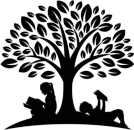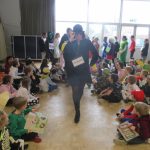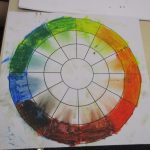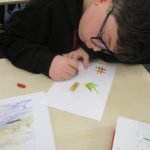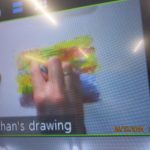On Thursday 7th March we celebrated World Book Day. Each of us dressed as a word to celebrate our rich and varied vocabulary. We wrote a definition for our chosen word and thought about synonyms and antonyms too. The creativity and imagination was incredible. We took great delight in strutting down the aisle during the whole school vocabulary parade. What a truly tremendous effort! Words in Willow Class included: rebellious, jovial, injured, nocturnal, juxtaposition, athletic, unique, spaghettification, discombobulated, swagger, blushing, crazy, sleepy, somnolent, nefarious, potato, artist, fancy, puzzled and incognito.
Mr. Dave Willett, one of our lovely Governors, visited us earlier in the week to share his love of reading. He read from one of his all time favourite books and we had to try to work out the character being described. After lots of clues including long black cloak, shiny black hair, white shirt and cane, we agreed it was Lucifer! It was a dramatic extract, read brilliantly and enjoyed by us all. Mr. Willett is a great ambassador for reading and he spoke passionately about the impact books have had on his life. Thank you for sharing this love of reading with us, Mr. Willett. It is always such a pleasure to be read to.
This year the National Gallery in London celebrates its Bicentenary – 200 years of bringing people and paintings together. It houses some of the world’s greatest paintings and is free to visit. On Tuesday, we had the wonderful opportunity of working with the National Gallery for an online workshop. Our session was all about the works of Claude Monet, a French Impressionist painter, and his use of colour. Many of the paintings in the National Gallery are very old. We can see this by the scenes depicted in the paintings. The clues are often the clothes worn by the people in the paintings and the subject matter. Paint in tubes was not available until the start of the 1900s and many of the paints for these pictures used pigment from nature (berries, bugs and beetles, precious stones such as lapis lazuli and even cows’ urine!).
Thi
We looked closely at one of Monet’s paintings to really understand his processes and the tools he used. Monet was predominantly interested in the following three things when painting: colour, light and nature.
Did you know that Monet only ever used 9 colours in his paintings and he never used black? So it is no surprise that colour mixing was a huge part of Monet’s work. We explored colour through the use of the Primary colours – red, blue and yellow and used these three colours to make different shades and create different effects. How many different shades of green do you think you could make just using yellow and blue?
We tried using some of the mark making techniques used by Monet. Straight lines, curved lines, dashes, scumbling, cross hatching, stippling were just some of the marks we tried with the Primary colours. What a wonderful way to spend an afternoon!
To help mark International Women’s Day, on Friday we went ‘shopping’ for special gifts for our special mums. Gifts were carefully chosen and parceled up. This Sunday, we look forward to treating our mums and saying a big thank you to them for all they do for us.
Have a lovely weekend.
